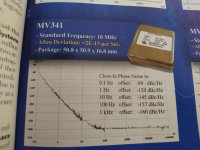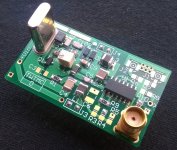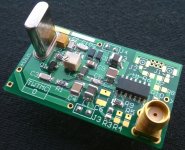I'm not sure I fully understand this claim but it seems to be that random frequency modulation in the 1 Hz to 100 Hz (?) is audible at what are very low levels. I think its fair to say these variations are as much as 100 dB smaller that the wow and flutter of a conventional turntable or tape transport. This is why I think a real effort needs to be made to test and quantify audibility.
This modulation should be pretty easy to spot as sidebands on a carrier in the analog output. Possibly a low frequency carrier (100 Hz) would show them more but they should be present on a 1 KHz carrier. Another way would be to look at the time interval variation on a 1 KHz tone. This would be more sensitive to cycle to cycle variations.
However I may have completely misunderstood this.
Just imagine the horrific effects of a vinyl disk being off-center by 0.1mm.
Many have a center hole diameter that easily allows for that. Now imagine
that at the middle of the track at a radius of 100mm there is a constant 1KHz
sine recorded. The played back sine would have a +/- 1Hz frequency modulation,
and the equivalent phase modulation. Now that's what I would call a large scale
effect. The zero crossings would be off by +/- 1usec.
Compare that to the ps jitter of a reasonable crystal oscillator and the alleged
greater sensitivity towards lower frequencies. And the lower the output frequency
is, the more oscillator cycles are required for 2 pi of the output. And yes,
their noise averages out, the lower the output, the better.
Maybe a better mousetrap in hi end would be an automatic disc centerizer.
For a reality check, the attachment is one oscillator my customers use. Not exactly cheap, but mass production.
Attachments
However, I will place my bet on the Driscoll as number 1, with the Pierce coming to a very close second.
Why??
I believe the Driscoll produces the highest Loaded Q than any other circuit and a 11.2896 MHz AT-cut Driscoll
will be the winner.
So, you think this will be the winner...
I vote for the Driscoll with SC-Cut crystal, because the crystal Q is around 850K and the calculated loaded Q should be around 750K.
Attachments
********************************So, you think this will be the winner...
I vote for the Driscoll with SC-Cut crystal, because the crystal Q is around 850K and the calculated loaded Q should be around 750K.
Thank you Andrea and Gerhart...What about nr 2?
BTW, Are you using the RutgerS sine-square converter?
.
Last edited:
For me, it's the Butler. And remember, you need to suppress
the parasitic resonance at +10% or so. That, and selection
of the right overtone need a place to go in.
the parasitic resonance at +10% or so. That, and selection
of the right overtone need a place to go in.
********************************
Thank you Andrea and Gerhart...What about nr 2? ;-)
Well:
for fundamental AT-Cut crystals up to 25 MHz, I believe the best will be the Colpitts-Clapp and the Pierce
for overtone AT-Cut crystals up to 50 Mhz, I think the winner will be the Driscoll
for overtone AT-Cut crystals around 100 MHz (90/98), I vote for the Butler (foto finish with the Driscoll)
for overtone SC-Cut crystals, from 10 to 50 MHz, my vote is for the Driscoll
********************************
Thank you Andrea and Gerhart...What about nr 2?
BTW, Are you using the RutgerS sine-square converter?
.
Yes, the squarer is the same of the TWTMC-C Clapp oscillator.
This is the Driscoll with AT-Cut crystal at 98.304 MHz.
Attachments
********************************
BTW, Are you using the RutgerS sine-square converter?
.
Me? No.
Either a limiter like the one often cited from Wenzel.com
(which is really a textbook standard) but works good enough
for comparing a hydrogen maser and a cesium in a dual
mixer downconverter.
Or that Linear Technology LTC6957.
Speaking of Wenzel:
My own Stanford SR620 counter has the precision timebase,
and this is made by Wenzel, actually. We measured it last week
against the house standard, and it was 1.6e-13 over a second,
still getting better over tau. Must have been a lucky buy
over eb*y.
...Or that Linear Technology LTC6957...
******************************
A very interesting component (LTC6957-1). Specially wrt its ad-jitter figures and dual outputs.
Gerhard-
Is the LTC6957 as good as they claim? Certainly interesting. In this application would it be better than a good fast inverter like a 74AC? At $5 vs. about $.10 it would need to be significant. I could not find the Wenzel limiter circuit in their library. Do you have a suggested search term?
Stanford Research sales guy swore they make their own 10 MHz oscillator. Maybe they were "short on inventory" (or slow to replace the labels) when they built your 620. They do make their own Rubidiums. And even an audio market variation.
Its very hard to beat the performance of a Wenzel. My reference is an Arbiter GPSDO that has a big 5 MHz Wenzel internally. I figure improving on it would be a very low return on effort task.
The Morion's are very good values. I'm surprised no one has ordered up a batch of audio frequency oscillators from them and made them available to the audionut marketplace. Of course dealing with Russia brings some hurdles.
I think this is very interesting for these applications: http://www.wenzel.com/wp-content/uploads/cmososc.pdf (The inverter is a 7S04, not a 7504) If its performance is good enough it would be very attractive for many audio applications. I suspect it could be injection locked with a small (5 pF) cap to the input of the gate.
Is the LTC6957 as good as they claim? Certainly interesting. In this application would it be better than a good fast inverter like a 74AC? At $5 vs. about $.10 it would need to be significant. I could not find the Wenzel limiter circuit in their library. Do you have a suggested search term?
Stanford Research sales guy swore they make their own 10 MHz oscillator. Maybe they were "short on inventory" (or slow to replace the labels) when they built your 620. They do make their own Rubidiums. And even an audio market variation.
Its very hard to beat the performance of a Wenzel. My reference is an Arbiter GPSDO that has a big 5 MHz Wenzel internally. I figure improving on it would be a very low return on effort task.
The Morion's are very good values. I'm surprised no one has ordered up a batch of audio frequency oscillators from them and made them available to the audionut marketplace. Of course dealing with Russia brings some hurdles.
I think this is very interesting for these applications: http://www.wenzel.com/wp-content/uploads/cmososc.pdf (The inverter is a 7S04, not a 7504) If its performance is good enough it would be very attractive for many audio applications. I suspect it could be injection locked with a small (5 pF) cap to the input of the gate.
It is the differential amplifier thing in
< Waveform Conversion | > .
These papers are more an intro for beginners and for sure not
the real thing that he uses in his top of the line boxes. He is
not dumb to give away the real secrets. But it's a good primer.
There is another paper by some Oliver Collins
that is behind the IEEE wall of shame between us and the
knowledge. But I have seen it in the wild on the net.
He proves that optimum slope amplification should be done
in several steps: slow filters in the first stage and then, as
rise time builds up, correspondingly faster ones. That especially
makes sense if you convert 2 100 MHz
oscillators to 100 KHz with a common down conversion
oscillator, so you can compare their noise/jitter on the low frequency
with greater detail. The down conversion osc hits both channels
in the same way and cancels out, at least a lot of it.
< IEEE Xplore Abstract - The design of low jitter hard limiters >
When you start at 20 MHz, it's not that important compared to the 100KHz
case, but LT seem to have implemented it as far as it makes sense.
The LT chips work.
With the Stanford, I can only say what's inside mine. I did not open
those that we have on the job. Maybe they make the standard timebase
themselves, it is not a world wonder. It does not make sense to develop
sth. like that precision timebase for a small company.
It takes too much wall clock time, even if you can do the engineering.
My timebase was a disappointment when I powered it up, now after
6 weeks continuously on, it is in a completely different league.
Just imagine the resulting cycle time if you try to optimize.
regards, Gerhard
< Waveform Conversion | > .
These papers are more an intro for beginners and for sure not
the real thing that he uses in his top of the line boxes. He is
not dumb to give away the real secrets. But it's a good primer.
There is another paper by some Oliver Collins
that is behind the IEEE wall of shame between us and the
knowledge. But I have seen it in the wild on the net.
He proves that optimum slope amplification should be done
in several steps: slow filters in the first stage and then, as
rise time builds up, correspondingly faster ones. That especially
makes sense if you convert 2 100 MHz
oscillators to 100 KHz with a common down conversion
oscillator, so you can compare their noise/jitter on the low frequency
with greater detail. The down conversion osc hits both channels
in the same way and cancels out, at least a lot of it.
< IEEE Xplore Abstract - The design of low jitter hard limiters >
When you start at 20 MHz, it's not that important compared to the 100KHz
case, but LT seem to have implemented it as far as it makes sense.
The LT chips work.
With the Stanford, I can only say what's inside mine. I did not open
those that we have on the job. Maybe they make the standard timebase
themselves, it is not a world wonder. It does not make sense to develop
sth. like that precision timebase for a small company.
It takes too much wall clock time, even if you can do the engineering.
My timebase was a disappointment when I powered it up, now after
6 weeks continuously on, it is in a completely different league.
Just imagine the resulting cycle time if you try to optimize.
regards, Gerhard
Last edited:
Gerhard, to satisfy my curiosity... In what range are Morion Oscillator prices? (not that I intend to buy one)For a reality check, the attachment is one oscillator my customers use. Not exactly cheap, but mass production.
The specs seem rather good....
I have never asked. I have personally bought only some mv89 from ebay, and the results are quite mixed, from state of the art to defective. Especially those from China have often been removed from their cell phone station by sheer violence, and it shows.
I'd estimate a few €1000. I have asked the German distributor for the price of a 100 MHz oscillator by Pascall and it was abt. €4500, IIRC. It was good, but nothing I could not do myself and have somebody sort the crystals.
I also have bought quite a lot of Lucent plug ins that contain a 5 MHz SC cut MTI 260, built by Agilent and never used (spare parts). I can unsolder them carefully myself. Not with a blowtorch & not with a hacksaw.
I'd estimate a few €1000. I have asked the German distributor for the price of a 100 MHz oscillator by Pascall and it was abt. €4500, IIRC. It was good, but nothing I could not do myself and have somebody sort the crystals.
I also have bought quite a lot of Lucent plug ins that contain a 5 MHz SC cut MTI 260, built by Agilent and never used (spare parts). I can unsolder them carefully myself. Not with a blowtorch & not with a hacksaw.
Last edited:
I think this is very interesting for these applications: http://www.wenzel.com/wp-content/uploads/cmososc.pdf (The inverter is a 7S04, not a 7504) If its performance is good enough it would be very attractive for many audio applications.....
**************************
Thank you 1audio for the link.
Indeed it is a very tiny little circuit, but don't let its simplicity fool you ;-)
I can assure you that once properly designed, it will have astonishing performance, demonstrating the power of the Pierce circuit mechanism.
Interesting thought about ILO. Its the first time I'm hearing the idea here on diyaudio.
--------------------
Keep up the good work, gentlemen.
I have never asked. I have personally bought only some mv89 from ebay, and the results are quite mixed, from state of the art to defective. Especially those from China have often been removed from their cell phone station by sheer violence, and it shows.
I'd estimate a few €1000. I have asked the German distributor for the price of a 100 MHz oscillator by Pascall and it was abt. €4500, IIRC. It was good, but nothing I could not do myself and have somebody sort the crystals.
I also have bought quite a lot of Lucent plug ins that contain a 5 MHz SC cut MTI 260, built by Agilent and never used (spare parts). I can unsolder them carefully myself. Not with a blowtorch & not with a hacksaw.
Ouch! that pricing is pretty high. I got a quote from Wenzel for 22 and 24 MHz oscillators in small quantities, either a small fry or a timekeeper (I don't remember which) at around $500 ea. Lead time was I think 12 weeks. That was 7 years ago so I'm sure its all changed. The Bluetop ULN was a different story and not exportable so not an option.
************************
Draw a rough sketch of your idea....

Very rough sketch ... 6 refers to a 6mhz clock oscillator, 24 to a 24 MHz clock oscillator. The two clicks could lock and produce an error signal which could modulate the 24 MHz clock
Last edited:
That is a classing way to get lower phase noise at a higher frequency. I'm not sure if it reduces the HF phase noise or the close in phase noise. You should be able to get the best of both at the higher frequency.
Here is a more detailed discussion than you will find elsewhere on the subject: Phase-Locking ULNs for Optimum Performance |
Here is a more detailed discussion than you will find elsewhere on the subject: Phase-Locking ULNs for Optimum Performance |
Last edited:
That is a classing way to get lower phase noise at a higher frequency. I'm not sure if it reduces the HF phase noise or the close in phase noise. You should be able to get the best of both at the higher frequency.
Here is a more detailed discussion than you will find elsewhere on the subject: Phase-Locking ULNs for Optimum Performance |
If multiplying is better than dividing would it be better to just use a lower frequency clock and multiply up when needed for DSD256,512 or even DSD1024 (if that is ever needed)?
Depends on your budget and what you start with. The setup described would be around $15K to implement. I'm not sure your audio would be better at the end. I'm still not convinced that clocking is a limitation today. Execution is a much bigger issue usually. Good clock and bad ground bounce is a waste.
Sent from my SGH-M919 using Tapatalk
Sent from my SGH-M919 using Tapatalk
- Status
- Not open for further replies.
- Home
- Source & Line
- Digital Line Level
- The Well Tempered Master Clock - Building a low phase noise/jitter crystal oscillator


